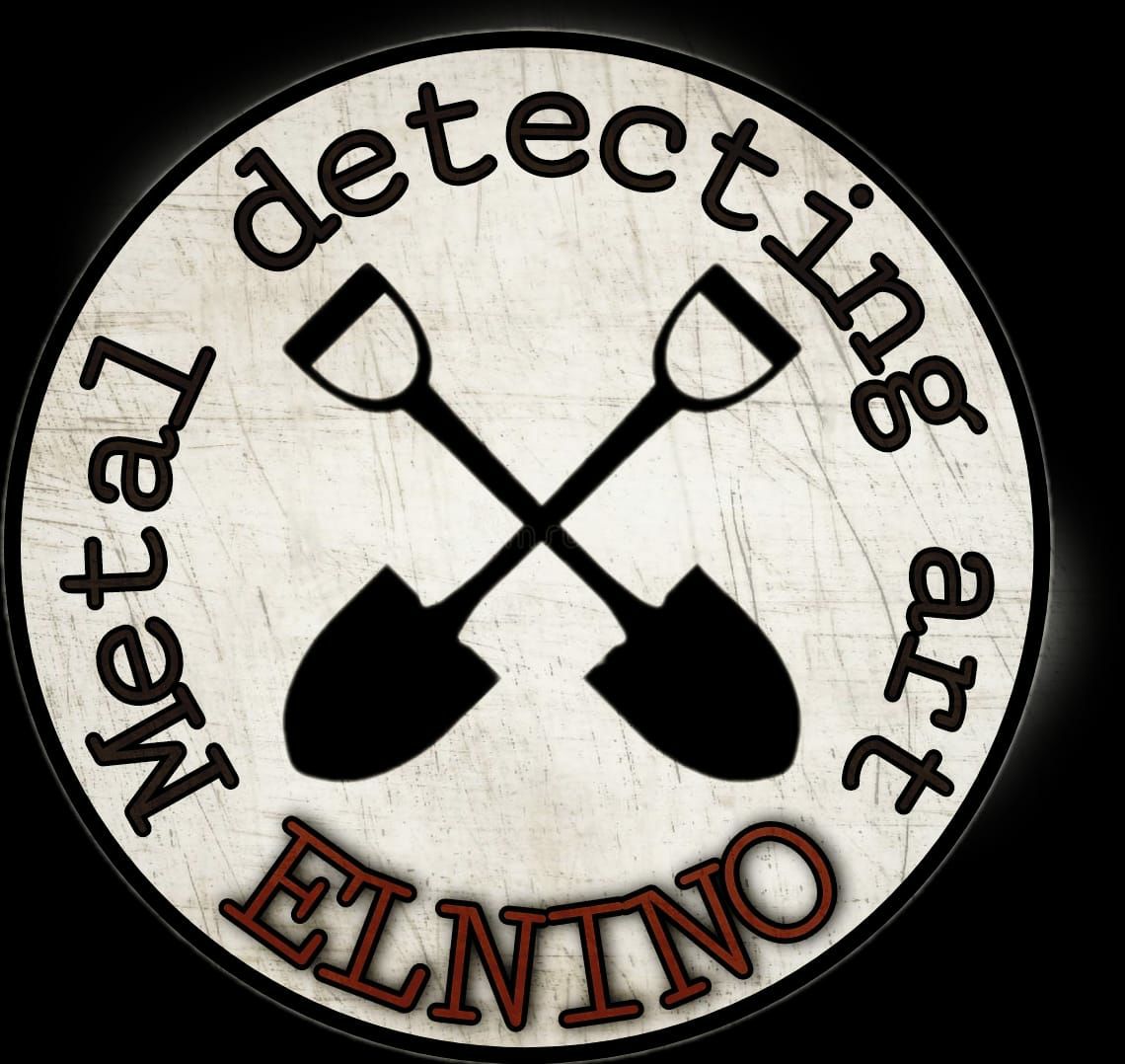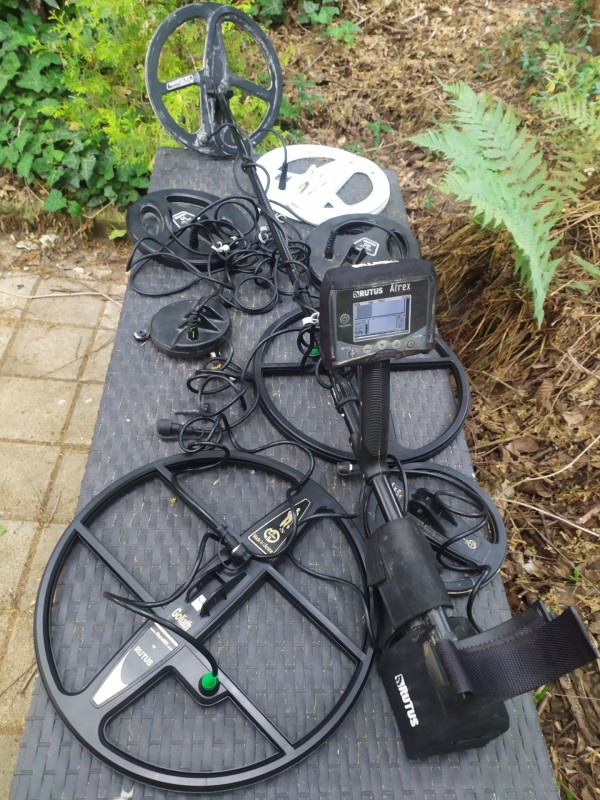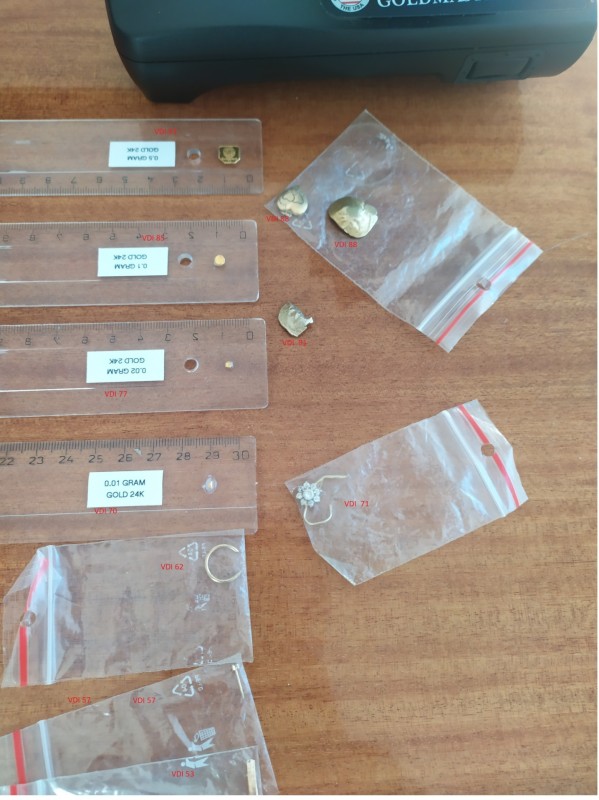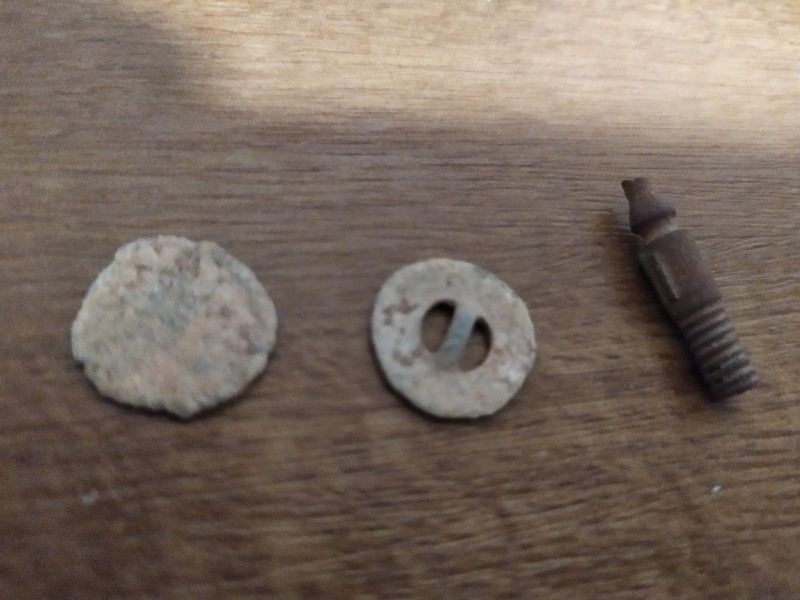-
Posts
1,348 -
Joined
-
Last visited
Content Type
Forums
Detector Prospector Home
Detector Database
Downloads
Everything posted by EL NINO77
-
How fast you sweep with the coil at a certain recovery speed will strongly depend on the mineralization of the terrain ... because in lightly mineralized terrain you can also sweep at a fairly low recovery speed ... relatively fast .. and you will still receive a signal from the target from both sides of the coil sweep every time ...even on deep targets.. The problem starts if you go to detect at a similarly low recovery speed in more mineralized terrain... and with a quick sweep with the coil you start to pass deeper targets.... ..That doesn't mean that you won't find shallower targets... Yes.. but you won't be able to reliably detect deeper and deeper targets...or not at all.. .. A good advice is if you have a detector that has a fixed lower ground filter/recovery sped/ it is to slow down the coil sweep speed in such terrain... and thus enable the detector to optimally detect targets in such terrain... If you have a detector that has an adjustable recovery speed, then in such a terrain, increase the recovery speed to a higher value/ the best optimal for this terrain... and then you can sweep the coil again at normal speed... and you will be able to reliably detect even deeper goals... what is the optimal recovery speed for the given terrain? That - will depend on the strength of mineralization of the terrain... Furthermore, it will also depend on the degree of contamination of the field with iron, because the higher recovery speed does not see the iron from the side of the coil as far as it is with the low recovery speed, and therefore the higher recovery speed better unmasks good signals in the field... which is covered with iron waste.. if you are starting detection in some terrain... normally I recommend using medium high recovery speed...
-
First, let's ask ourselves a question... what is hidden under the name recovery sped? The degree of certainty of recovery sped is actually the setting of two parameters: the certainty of the type of ground filter and the time of operation/recovery/ of this ground filter. These two parameters are optimized for each level of recovery sped... and in general, it is the case that the higher the group filter is set, the faster the recovery work of this filter is. In general, it is true that a certain value of recovery speed will be the most optimal for the day type of mineralization of the terrain.. because too low a recovery will not filter the signal of the terrain well and may also be unstable ..-and therefore you will not find deeper targets... and..on the other hand, if the recovery speed is too high, the detector will become very stable, but in such a terrain.. it is shallow ... and therefore you will not find the deepest signals either... But if you set the optimal recovery speed ... for this terrain ... then the detector will be sufficiently stable and will also have an optimal depth in such terrain...
-
it can be seen that your terrain is very strongly magnetically mineralized with Magnetite... and that is why your highly conductive coins will pass from the iron zone very quickly, even from deep, while less conductive bronze and even less conductive lead ... are able to resist better of the non ferous VDI signal. with the depth of detection...,,,
-

Minelab X-terra Pro Vs Nokta Simplex
EL NINO77 replied to ☠ Cipher's topic in Metal Detector Advice & Comparisons
X terra pro has the option of wirelessly connecting headphones.....!!! It can be seen that Minelab is going from X Terra Pro very seriously to the fight for market dominance... in this price category... and this is also indicated by the options and settings of XTerra Pro... let's not forget that Minelab has already managed to put on the market the multi-frequency detector Vanquish 340 for 240 euros.....and it is possible that it will also innovate this class of detectors...which I would consider logical.... -

Do Fertilizers Affect Performance?
EL NINO77 replied to Digalicious's topic in Metal Detector Advice & Comparisons
First of all, you need to realize.. what does the conductivity of the terrain do... it is natural saline terrain, salt lakes, bogs, coke,...sea water and beaches .. terrain that contains natural or artificial fertilizers, lawns - which are often fertilized, terrain containing certain the proportion of non-ferrous metals - these terrains have one thing in common - they produce a non-ferrous signal response with a very low VDI.. it's not just about the fact that this terrain gives a signal response for the detector,,, another disadvantage is that such a low-conductivity signal can merge with the signal of the target - and very strongly reduce... the actual VDI of the target... If you also add to that a certain share of the iron response of the terrain in such a salty terrain, the deep signal can go to the iron zone of the VDI more quickly... if we can prevent this..? and what do detector manufacturers do?. Mostly ... they use multi-frequency programs that have salt signal elimination in them ... and thus improve the stability ... of the detector detection ... and also the stability of the VDI target ... in such a conductive field ... if I want to find out which program has built-in salt elimination ... you can find it out very quickly with the help of an airtest with a compact CD - which simulates conductive terrain very well ... and is also widely used for calibrating detectors to eliminate the salt signal.. I devised a certain test procedure.....I used this test procedure, but in addition to the test on the CD disc, I also expanded it to include a test on the DVD R disc. the detector sees a CD disc and a DVD-R disc, which has a stronger metal layer and imitates a stronger conductive response. For example, you will quickly find out the differences between different programs, for example Park 1, Park 2, beach 1,2 If you don't have a multi-frequency detector... you can use 1 frequency detector with a variable frequency and quickly find out how the 1F frequency is the most resistant to the field's conductivity. ..One thing to be reminded here.... programs with salt elimination... definitely lose sensitivity to very small low-conductivity targets,,,!!! ------------------------------------------- The program with the elimination of field conductivity...the detector does not detect the CD!!! ---------------------------------------------------- Program.. without elimination of field conductivity.. The detector detects both CD and DVD-R discs --- from a very long distance ... this means that this program will be significantly less stable in the conductive field..!!! -
....coils from X-terra pro will not work on Equinox, we would probably like a lot... On the contrary... the coils from the Equinox will work on the X-terra Pro... and that's an advantage for someone who already has an Equinox...
-
For MXT, for open fields, clearly 13" Detech ultimate, and as a small coil, 6x8" SEF,, or possibly a 7" Ultimate coil..
-

The Best Metal Detector Out There
EL NINO77 replied to Chase Goldman's topic in Metal Detector Advice & Comparisons
...Daniel.... Did you have the MXT Pro detector?,,, how did it work in your terain ? ....it is one of the detectors that work in mix mode...I think it has potential... For me, it is important to have a detector that is effective in detecting in the fields where I am detecting... I prefer a multi-frequency/1 frequency detector with Mix mode...with the possibility of using a sufficient assortment of coils... -

Inital Thoughts On The Garrett 24 K Goldmaster
EL NINO77 replied to wltdwiz's topic in Garrett Metal Detectors
Cris ... if you want to use the Goldmaster 24k for coin and relic hunting ... you will have to first think about what type of coin you are looking for ... If you are moving in the territory of the old world.,,, then the Goldmaster 24k..can really be used for polishing small hammered silver hammered coins /low and medium conductive coins/...as well as some bronze artifacts - which are often low-conductive...and searching for possible golden targets... but consider that the VDI of targets can rise faster to the value of 95-99 on deep targets... - because the normalization of VDI is calibrated for this detector to - its natural frequency of 48 khz.. Goldmaster 24K with a 6x10" DD coil has no problem hitting and giving a good signal with VDI on my low-mineralized test field on a small 14mm silver earring at 20cm, a small 14mm -0.45 gram silver hammered coin at 23cm, and a 0.05 gram small gold eyelet measuring 4x5mm on 10 cm into the ground... we can say that this detector is optimized for such targets.. On the other hand, expect a smaller range on highly conductive targets such as highly conductive silver and copper coins /from silver dimes to silver dollars / ... because the Garret 24K by working at 48khz has a naturally reduced range on these highly conductive targets, but also because... these targets, which initially have a very high VDI, move faster with the depth of storage to the Vrap/to the iron zone/.. In practical detection, working with the goldmaster is pleasant, mainly because it eliminates iron quite well, and using the higher discrimination set to 63... allows you to eliminate certain targets made of aluminum foil, even if not all... In my opinion, if a 9"-11" round DD coil was available on the gold master, the possibilities of the detector for searching for coins would be significantly enhanced... because a larger coil increases the sensitivity of each detector for high-conductive coins.. For curiosity's sake, the VDI value of some golden targets in the airtest..: You can also use the Goldmaster 24K to detect coins, but be aware that this detector will be more sensitive to low-conductive and medium-conductive targets. -
Higher TX performance is not new for detectors,, from my detectors I have TX Bost Whites Spectra V3 detectors, then the Vista Gold Gain 30 khz detector in bost mode,, and the AKA Signum MFD detector...in Turbo Mode... All these 3 detectors, in addition to the possibility of turning on the TX boost, also have a manually adjustable RX Gain, so you can really adapt these detectors to field conditions... There are terrains where turning on the increased TX boost will work much better than normal TX... mostly in mild and moderately difficult terrain conditions... where it will work really excellently and will actually increase the range by 10-15..% more.. ..These are also certainly terrains that absorb the power of the detector... and work with a TX boost will really be more effective in depth... a depth that you cannot reach without a TX boost... In highly mineralized terrains, increased TX may no longer be the best option, but it can still work quite well... provided that we set the RX gain on the detector to a sufficiently low level.. In practice, the increased TX bost is really quite usable... with the exception of terrains with very high mineralization... and moderate and moderately demanding terrains will bring a real depth bonus.. ...If the weather is good... at the end of the week... then I will have the opportunity to test the Manticore,, as well as my Equinox 800 and possibly the CTX,,, on moderate but also on heavily mineralized terrain... so I will be able to write something about Manticore...
-
I'll note on the side... when I did ATX testing a when I last year ..on a 12x10DCD coil. on targets of 0.1 gram of gold and less.,, and I compared it with a smaller classic coil 5x10"DD Infinium coil.... I quickly understood the advantage this type of coil is used for ATX and now for Axiom... and I saw a hidden potential in it... because the 12X10" coil had an excellent range on larger targets and at the same time proved to be more sensitive on very small targets than the 5x10 DD infinium coil.. . if Garret makes a smaller 5x8" DCD coil for the Axiom of similar construction... then such a coil will be able to increase the sensitivity on small targets even more... in its size category..
-
I think ... that the difference between high-end multi-frequency and 1F detectors is not great ... even on reasonably deep targets ... or the separation of a target in iron ... it's more about ... how experienced and knowledgeable the detectorist is with your detector... And it's not only about detecting the target...and comparing detectors on good targets,,, but it's more about how much unwanted waste it digs up for one good target found...that means how many iron bottle caps, and aluminum foil, or even small ones you have to dig up pieces of non-ferrous metals to dig up a coin, for example... I call it the efficiency of the detector.... and it can already differ significantly between individual detectors,,, and for me it is one of the essential things in a certain type of detection.. ....These properties will depend on the terrain,,,, on a clean terrain with almost no waste, the differences between the detectors can be very small... but in other situations I will prefer a detector that can deliver good findings to my table... And as Steve says..... you will have significantly more finds with your old detector in new terrain... than in really heavily traveled terrain with the newest detector... that's a clear fact... Heavily traversed terrain requires... the use of several different detector settings and the use of at least 3-4 different sized coils... because even the best detector cannot detect everything well on only one standard 11" coil... Finally, I want to say something... Every technically excellent current high-class multifrequency detector can have an edge and detect better in a certain type of Terrain, or in a certain type of detection..... and here for some one detector can work better than the other. PS.....I think Loren gives good information...but clearly the comparison of detectors on 500-1000 targets...I take that with a certain reserve...I think he didn't mean it literally...👍 ...In my comparisons, I look more at what the second detector finds in the field after the previous detector,,, and also how much ferrous and non-ferrous waste will be picked up by one and the other detector....
-
... something to think about,,,, there are many excellent 1-frequency detectors that excel in separation and depth of detection,,, that X-tera Pro can be one of them.. but that will be seen in the tests with the first users.. The possibility to combine and use coils from the Equinox and Vanquish series can also be a strong reason to buy X-tera pro.. but it also points out how powerful a tool Minelab's targeted marketing is... Likewise, I wouldn't see a problem using, for example, coils for ETRAC on my CTX 3030... if MInelab took a similar step... On the other hand, not using the frequency of 20 and 40 khz - hints X - Terra does not feel like a gold prospecting machine with a true all metal mode .... I mean in this price category ... what is the change compared to the old X Tera 705 ... Minelab may be preparing a place for its new gold prospecting machine.. The new construction does not surprise me... I myself use the Vanquish 340... not as a detector with an S rod but as a detector with a straight rod.. One thing is certain... 1 frequency detectors are not yet at all .. outdated...👍 As they say here..."never say never"...!!! But on the other hand, it must be said that multi-frequency and single frequency have their strengths as well as weaknesses..... it depends on the terrain,,, EMI..,, and the type of detection... Because both of these options 1F frekvency and Multi F frekvency , if they are well optimized...they are already Technically...better "Predisposed" for a certain type of detection situation...!!! where most of the advantage ...of one of the Alternatives is redeemed by the fact that it is...: "Something for Something" .....
-

Equinox 900 Or Manticore?
EL NINO77 replied to Steve Herschbach's topic in Metal Detector Advice & Comparisons
Simon .. I have one question for you... what results do you get with the Manticore and Equinox on 11" coils in the #9 lead shot in test? ...since I have done many such comparisons on my detectors over time...so I am interested.... -

Equinox 900 Or Manticore?
EL NINO77 replied to Steve Herschbach's topic in Metal Detector Advice & Comparisons
This video from Andrew /Abenson/..clearly shows ... that the sensitivity of the manticore to small golds is slightly lower than that of the Equinox 900, on the same size 11" coils ... ....Thank you for the test..👍 ..Andrew.... do you think that the situation can change.... if the test were done on smaller coils..?/ but for manticore we have to wait for a small 5.5x8" coil../ -

Wall Of Fame Pic # 3
EL NINO77 replied to George Kinsey's topic in Metal Detecting For Coins & Relics
Kac..... you have a chance to level up ,,, with George... but I have to admit that 6 detectors is a good basis for that...👍... P.s .....What I like about George is that he uses detectors from different manufacturers for detection... from all over the world... and he has an overview of what each detector can do,,, and what are its strengths... in of the given detection..👍... -
X-terra Pro..I was interested in the beach program...I think this program can have a multi-frequency element?.. /elimination of terrain-water conductivity?/ ....other programs can run on one selectable frequency....it is such a competition to Deus1/ORX...but also to other detector manufacturers... Personally, I think this is how the first Vanquish should have looked... The shape of the coils is identical to the one from the Vanquish line...so now I have a question...will the Vanquish and XTerra Pro coils be compatible?.. ...never underestimate single frequency detectors.... the ratio of my gold coins found by single frequency detector to multi frequency detector... is 11 gold coins for 1F frequency detectors... and 7 gold coins for Multifrequency detectors...
-

Deus 2 Vs Manticore. Relic Hunting In Hot Dirt.
EL NINO77 replied to Daniel Tn's topic in Metal Detector Advice & Comparisons
Jeff the question is ... what does Steve mean by the word ... "small non-ferrous materials" ... ist 0.1 gram, 0.3 gram?, 0.5 gram.., or something just under 1 gram gold ? For example, in my tests on a very small earring made of white 18K gold /very demanding target/ the 9" HF coil does not increase the range when using 30/54 khz on this earring, the range is 1.5cm max - but the signal quality improves.. With a small elliptical 5.5x9.5 HF coil, the range is already linearly greater ....-according to the higher frequency used... so I feel that the 9" coil - Deus2. can work similarly... -

Whats In Closet Number One?
EL NINO77 replied to George Kinsey's topic in Metal Detecting For Coins & Relics
George...I believe I have a similar view on this hobby.. as you... .Alone.. I have 26 Detectors...+coils.... I completely understand you.... even if the development of detectors is moving forward.... each of these detectors has its own detection logic... and it can be really good in some situations ...especially in combination with a good coil.. Detectors : 4x Garrett,5x Whites,5x Rutus,4x Minelab, 1xAKA, 3x XP, 1xTesoro, 1xDeeptech..,1x Fisher/Teknetics, 1xGolden Mask, .. will also come.. 27..? we will see... I like the detection options..and the detection philosophy of various manufacturers...as well as I see their pluses..and possibly also disadvantages..in detection..compared to other detectors..-signal quality, audio, discrimination quality and VDI accuracy, for example - even in separation... This also makes you think ... how can the new detectors be further improved, which are starting to be really very universal.. ..but many times it turns out..that even an older detector with the right coil... continues to meet really well the deep requirements for a current performance detector... For example... my first detector..... which I had the opportunity to use and detect../in 2011 year/ for some time... and now mine is -Garrett GTI 2500.. https://www.youtube.com/shorts/-xbivYJYP_8


.thumb.jpg.db566e9b9bc096e8ec327313a502e71f.jpg)
.thumb.jpg.d9cf9ca9f918fa0d67f1480e43c017f7.jpg)



.thumb.jpg.44815857da0ac12702ec0ac35340107a.jpg)